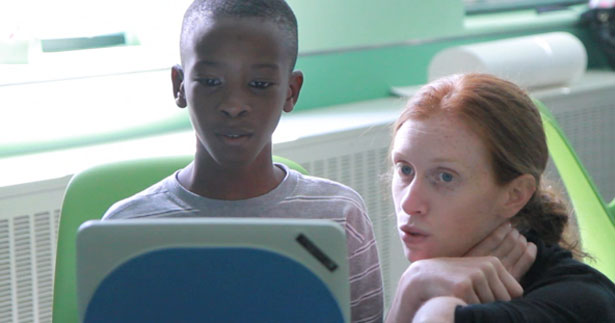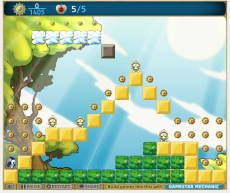 The 9th Annual Games for Change Festival is less than two weeks away! We are thrilled that our own Research Consultant Jessica Millstone and BrainPOP’s Senior Director, Educators Experience, Allisyn Levy, will present the findings of the first national survey on teacher attitudes towards games in the classroom. Their presentation will take place on Wednesday, June 20 at 12:10 in the Tishman Auditorium at NYU. Jeff Ramos of Games for Change took this opportunity to ask her a few questions about the research and its implications for teacher training.
The 9th Annual Games for Change Festival is less than two weeks away! We are thrilled that our own Research Consultant Jessica Millstone and BrainPOP’s Senior Director, Educators Experience, Allisyn Levy, will present the findings of the first national survey on teacher attitudes towards games in the classroom. Their presentation will take place on Wednesday, June 20 at 12:10 in the Tishman Auditorium at NYU. Jeff Ramos of Games for Change took this opportunity to ask her a few questions about the research and its implications for teacher training.
Games for Change: We often see organizations compiling their own independent research to further the understanding of their niche and the community they serve. For the presentation you’re going to give at the Games for Change Festival in June, you partnered with the educational game designers, BrainPOP. What unique things they did bring to the table through this partnership?
Jessica Millstone: I’m really glad you asked this question, because our collaboration with BrainPOP has been among the most rewarding parts of doing this research. As a teacher and a teacher educator (preparing teachers for their work in the classroom), I only knew about BrainPOP’s beautiful and informative videos on a wide array of subject areas. I didn’t know they were investing so heavily in digital games for learning. My research partner (and co-presenter at Games for Change) Allisyn Levy is the Director of Educator Experience at BrainPOP and is one of the leaders there in getting teachers to recognize the powerful qualities of games for learning, and her particular expertise finding and working with teachers who use digital games was invaluable to this project.
Interactive and game-based learning presents a host of challenges, and your research aimed to pin some of them down. From your research, what were some of the major issues you’ve found when this type of learning enters the home or a classroom setting?
I’ve helped schools and teachers use technology in the classroom for almost 15 years now, and while the technologies have evolved enormously, schools have not. It’s a real challenge for teachers working in a traditional school environment to change their practice and make use of all the exciting tools available. One thing that is a particularly stubborn challenge is the entrenched culture around professional development—teachers and administrators still aren’t that comfortable (or have the necessary time/resources) with taking charge of their own learning, especially when it comes to technology and digital games. One of the interesting findings of the Joan Ganz Cooney/BrainPOP national survey “Teacher Attitudes and Perspectives on Using Digital Games in the Classroom” was that teachers first learned about using digital games in the classroom through a traditional, on-site PD session, but in order to continue their learning they needed to turn to their peers or self-study to improve their practice. I believe that this kinds of self-directed professional development is going to be a key component towards getting digital games integrated into teaching & learning in a meaningful, consistent way.
As our society becomes more technologically advanced, the effects are seen everywhere. In what ways have you seen technology alter the classroom?
Technology itself doesn’t change the content most teachers deliver to their students, but its use demands that teachers and students engage with that content in new, interactive ways. It’s a huge opportunity for teachers to re-think the kinds of activities and assignments they create, so their students have a chance to show their new knowledge in a variety of ways. A well-made digital game is a particularly good assessment of knowledge-in order to play a game you need to know all the required content, and you also need to learn a good strategy for using that knowledge. Great teachers have always used games (and the new technologies of the day, really!) so now we are looking at the evolution from analog game play/design to digital game play/design in the classroom.
A large part of your presentation focuses on in-depth research into world of teachers. How did you conduct such a large-scale survey?
Our survey builds on two recently-released surveys about teacher perspectives on using technology in the classroom that were commissioned by the Gates Foundation and PBS. In both of those surveys, teachers identified games as one of the technologies they use in their classrooms, and we wanted to drill down into that group of teachers a bit and hear about their comfort level and frequency of use, and also their observations on how using digital games affects their students and classroom overall. We worked closely with a quantitative research company called VeraQuest to conduct the survey (they also did the aforementioned PBS survey so they have great experience surveying educators) and compile a preliminary data analysis, and at the Cooney Center we are still pulling interesting findings out of all the responses we got from these 500 teachers who took the survey!
What were you hoping to learn with data you were gathering?
This is really a first-of-its-kind survey. One of our primary objectives was to gather baseline metrics on teacher’s use of digital games and some of their observations so that the Cooney Center and other researchers can track this usage over time. But above all, we wanted to hear directly from teachers about how using digital games can change the way they teach and the way their students learn-and not just academic achievement, but also social / developmental learning. Promising findings include the high percentage of teachers who see that using digital games help re-engage their lower-performing students in learning, as well as help them personalize instruction and better assess those students. That is a huge boon to all teachers because every classroom has a range of learners, and many teachers struggle to meet their various needs. This survey shows that digital games can address that issue.
You’ve done something unique in that part of your data reflected on the personal and emotional feedback of your teachers. Why was this so important?
I’ve found through my work with early-career teachers at Bank Street College of Education that a teacher’s personal and emotional reaction to using technology has a huge impact on how they bring (or refuse to bring) technology into the classroom. Through the interviews for this research project, I wanted to see if a teacher’s personal use of video games (current, or memories of their own childhood/schooling) had an influence on whether they brought games into the classroom. Based on our case studies, it seems like teachers who identify as gamers are more likely to feel comfortable adapting commercial games (such as Minecraft or some of the video game design programs like Kodu or Gamemaker) into their curriculum. Teachers who are comfortable using analog games (like board or card games) might stick with educational games that are developed specifically for classroom use. But this is a finding we’d like to explore more deeply in our next survey so we can look at a larger sample of teachers.
Registration for the Games for Change Festival ends Friday, June 8, so be sure to sign up now! And use the code “cooney” to save 10% off the fee. See you there!




